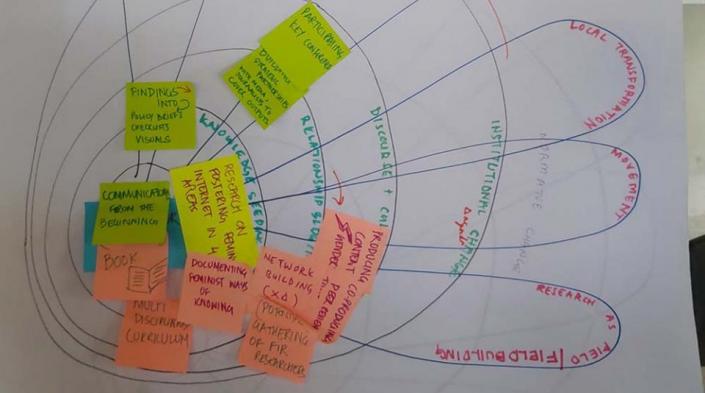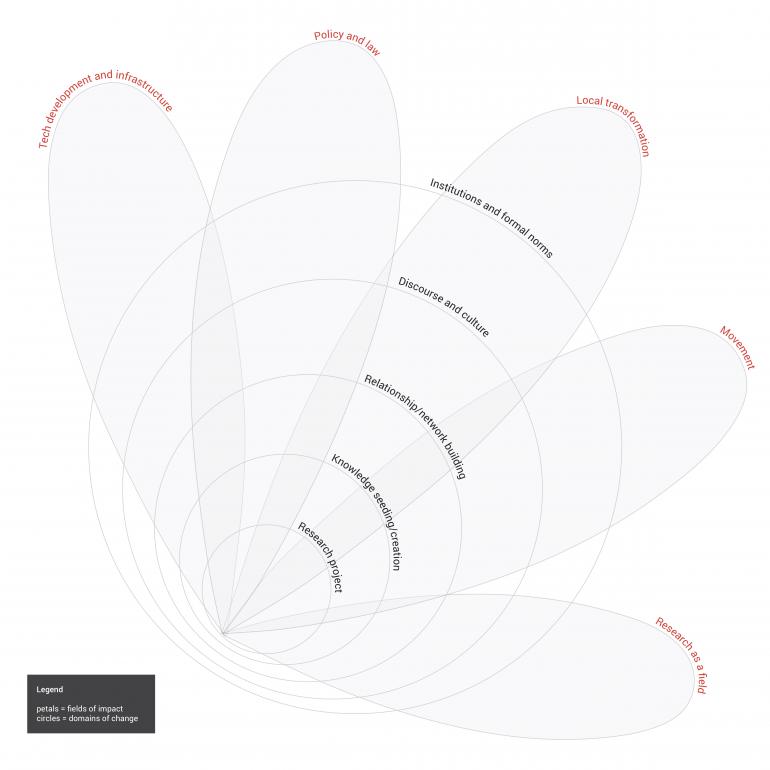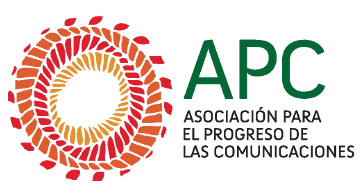 Image description: Flip chart with post-its illustrating domains of change. Source: APC-WRP documentation of meeting of Feminist Internet Research Network in February-March, Malaysia, 2019.
Image description: Flip chart with post-its illustrating domains of change. Source: APC-WRP documentation of meeting of Feminist Internet Research Network in February-March, Malaysia, 2019.
Actualizado por última vez en
The Feminist Internet Research Domains of Change diagram created and explored through the FIRN inception meeting is designed to:
-
Provide a framework for research project planning that can identify and prioritise specific fields where impact can be made;
-
Identify strategies towards that impact by specifying which domain of change the strategy aims to engage with;
-
Plot pathways for strategies to move between domains of change and field of impact that can be responsive to opportunities or strengths.
It builds from existing work by feminist thinkers around understanding and unpacking domains of change in gender power, which plots this change based on an axes of individual | systemic x formal | informal change.
The innovation here is three-fold:
-
The fields and domains identified are specifically intended for research for change types of initiatives/projects with a focus on the internet (with FIRN as a site);
-
The shape and form of the diagram is to support pathways that can move in different directions (horizontally, laterally, diagonally) between field of impact and domain of change, and in theory, can be dynamically moved at different moments in the duration of the project.
-
It is meant to support both project/activity planning, as well as evaluation and impact assessment at different life-stages of the project
However, it is important to note that this framework is work-in-progress, and the FIRN's project engagement with it is a critical part of assessing its usefulness. In other words, use it as far as it is helpful, and to note down as you go along its value and limitations. The idea is that FIRN (the network) can assess and improve it alongside with other research planning and implementation tools developed through this work for sharing with other practitioners in the field.
Unpacking the diagram
A. Circles/Spheres
These are domains of change as usually understood in work related to understanding gender power and impact.
The domains move outwardly in terms of spheres of influence. The assumption is that the closer the domain, the more influence the research initiative can have in through its design, approach and activities.
1. Research project
This is the immediate context and relationships that form within the context of the research project; or the “research site”. This is where the feminist research practices and value comes into play. Depending on how we build relationships in our local research, i.e. how we design our research project, our practices in the ethics of care, accountability, movement building, change in policy and law, networking and relationship building transforms relationships at that particular local level. Where attention to existing and unequal power relations and plans for shifting that can result in material changes between all persons and spaces involved. This includes at the level of the FIRN network. It is important to note that this does not assume pre- existing binary power relations that apply in all contexts.
2. Knowledge seeding/creation
This relates to new/evolving knowledge that can result in shifts in how we understand the world. This can be epistemic shift, such as new theories on the current understanding of an issue. For example, the FIRN feminist ethical guidelines we produced in the hackathon can serve as a contribution in the area of internet research. This domain is particularly interesting and critical in feminist research projects, where a common method is to surface intersectional and/or marginalised viewpoints and realities, and in the area of science and technology, can often have a goal of decolonising knowledge in this area and its historicity. The FIRN mapping project has already established that there exists a considerable gap in internet research, where FIRN is aimed to contribute to addressing.
3. Relationship/network building
This is often an invisible domain of change, which centres around forms of relationships that can or is aimed to be forged in order to transform power. It focuses on the connection between participants of a research project, whether directly through the research itself, or indirectly through engagement with the research findings in different forms. It can also include unintended forms of relationships that are forged his process, such as unanticipated actors coming together to engage with knowledge or activities of the research in transformative ways,
4. Discourse and culture
This domain of change often acts as a critical – albeit, hard to pin down - environment for institutional and normative transformation to happen. Impactful research that is communicated and engaged with at a broader, popular level is important in the aim to influence discourse and culture. This can also be in the form engagement with dominant or counter discourses, current positionalities, constraints and dynamics of particular institutions and infrastructure of discourse proliferation, embodied attitudes and behaviours, textures of relationalities etc. Postmodernist and poststructuralist theory of discourse and power can provide a helpful framework to think this through, but does not have to be the only or even primary one.
5. Institutions and formal norms
This relates to particular state, private and non-state institutions, which can be field- based, sectoral or at the level of geographical and/or community reach, and understands the role and power of institutions and underlying structural factors to shape social relations, and often manifests in the form of policies, regulation or resources. There are several different approaches already developed to assess and understand change in this area, such as the social relations framework that identifies give aspects shared by all institutions which has an impact on social relations: rules, resources, people, activities and (decision-making) power. This can be in the form of internal structural or protocol changes or external policy and legislative changes that influences access to and control over resources, or laws and policies that regulates behaviour.
B. Leaves/Petals
These are identified fields of change that can be influenced by or have an impact through of feminist research on digitally networked technologies and the internet. This is meant to locate where the specific activity or strategy is taking place or prioritised, and/or where it is envisioned to have most impact, energy and attention.
1. Local transformation
This is at the most direct level of engagement in the research, in terms of both thematic or issue focus of the research as well the communities who are understood to be most directly affected or invested in the research area.
2. Movement
This is at the level of engagement with movements who may directly or indirectly be interested, invested, or affected by the research initiative. Where the research can potentially inform or affect issues, agendas or causes championed by specific movements, through engagement at different domains of change.
3. Research as a field
This is about the field, processes and institutions of knowledge production, verification, and “truth-making.” It understands research to be located and subjected to particular protocols and institutions, and can also be a site for transformation through new practice, knowledge or questions.
4. Policy and law
This identifies specific policies or laws for engagement through the research project. This can be in terms of evidence-building towards advocacy for policy changes or legal reform, or responding to opportunities at different moments of the research initiative and beyond.
5. Technology development and infrastructure
This refers to the materiality of technology itself and embedded norms. This can be at the level of briefs, design, prototyping, protocols and standards, application, platform or infrastructure development.
How to use this diagram
The best way to use the diagram is to imagine it as something that will change as you move along in different moments of the research project. This includes at the stage of activity planning, assessment during key milestones, and evaluation.
The circles/spheres and leaves/petals are meant to be intersecting components. As such when you plot your activities into the diagram, consider both the domain of change as well as the field of impact that the activity intends to engage with.
Write down each activity in a post-it and place it on the intended domain and field of engagement. If this has connections – whether by design or through emerging opportunity – draw an arrow between them to denote the direction of this connection and change.
There may be more than one domain of change/field where an activity affects. To simplify the process, go through a prioritisation process to think through which you/your project would focus more energy on, or think it would have most impact.
You can either use this diagram in a digital form, by creating digital post-its using a pdf reader; or map it out on a flip chart paper and place post-its on it.
If in a digital form, save different versions of it as you make changes at different stages of the project.
If in a physical form, date the post-its at time of placement to denote changes through time. Or if you can think of another way to capture this change, please feel free to suggest it!
Example:
Strategy: To influence Facebook policy on addressing non-consensual dissemination of information
Activity: Storytelling circle as a way for participants to surface their experience with reporting to Facebook as a platform where online gender-based violence happened – [A1 x B5]
Activity: Article for academic journal on methodology that approaches participants as knowledge co-creators and oral stories as evidence - [A2 x B3]
Activity: Stories are turned into case-studies for lobbying at HRC, CEDAW and IGF [A2 x B5]
Activity: Stories are turned into audio-visual content with key messages for wider distribution on social media with a focus on speaking to women's rights and digital rights advocates [A4 x B2]
Activity: Dialogues are organised with key stakeholders and some research participants to discuss potential recommendations and solutions [A3 x B2]
Activity: Bringing research findings and recommending key allies to be part of Rights Con in a closed door meeting with FB [A5 x B5]
Questions to help in your planning
-
What is the domain of change your project would like to have the most impact in? Is there an emphasis on particular domains, and if so, what are potential factors that contribute to this? (e.g. leveraging current opportunities and capacities, identifying current gaps in transformation for engagement etc)
-
What is the field that the activity is prioritising engagement on for transformation?
-
Where are currently visible pathways of change?
-
What are the conditions needed for this change, and the factors that enable movement from one node of the pathway to another?
-
What would be your contingency plan if those conditions don’t happen? Where can you move the activity to, to influence different domains or fields of impact.

Image description: Domains of change. Designer: Cathy Chen


